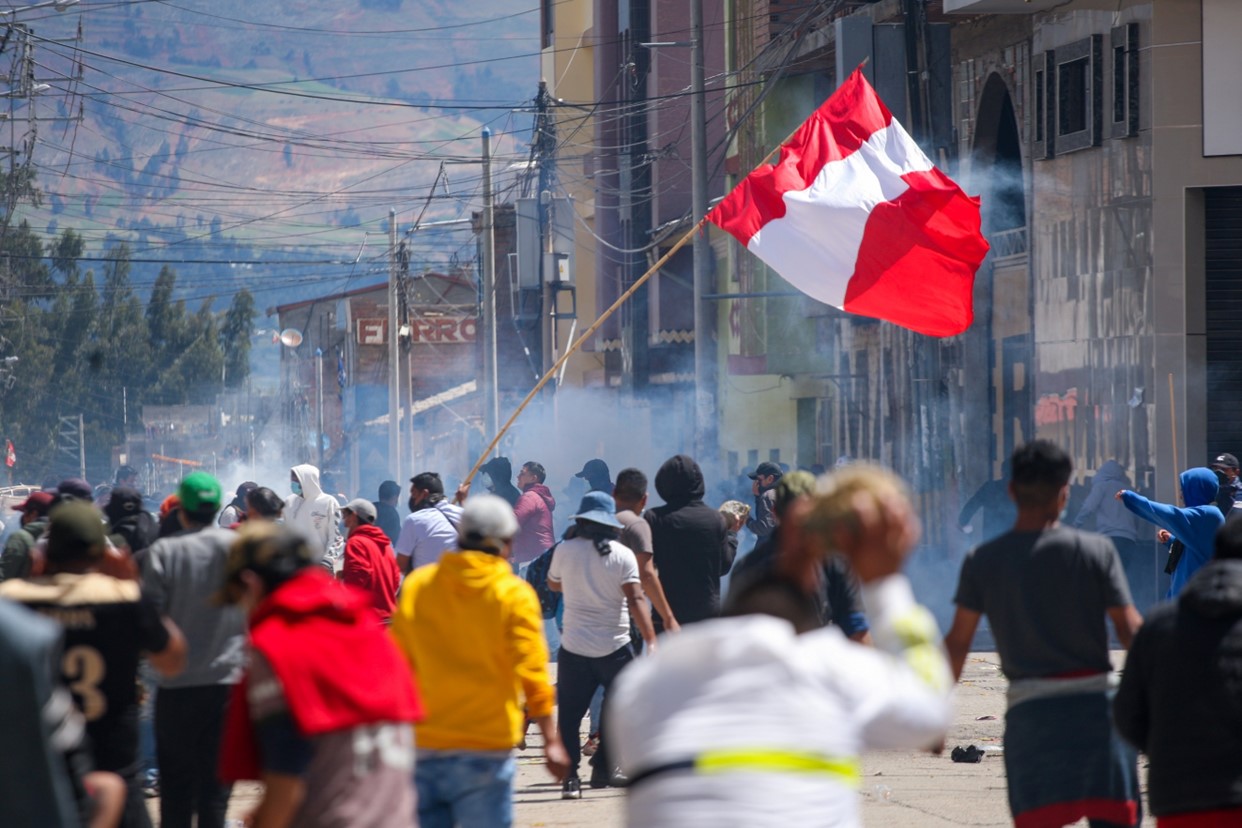Peru has been engulfed by violent clashes in recent months between protestors and the pro-government military resulting in the deaths of over 60 civilians. With recent polling suggesting 82% of Peruvians disapprove of the current government’s leadership, NGS Associate Analyst, Harry Sparke, examines the nature and motivations of the protests.
Introduction
Peru’s young democracy has been under continuous strain by various political and socio-economic challenges since its transition to civilian democracy in 1980. On 07 December 2022, the then democratically elected President and left-wing Pedro Castillo was impeached and ousted by the right-wing-controlled congress dominated by a coalition comprising of the Popular Force, Popular Renewal and Go on Country parties. His replacement, President Dina Boluarte, (who is seen by many as a puppet for the aforementioned right-wing parties) was instated without a mandate by congress. Since then, the new government has made clear its intention to ignore the will of the Peruvian people through its violent repression of dissent and use of emergency powers to strip citizens of their once constitutional rights, such as the right to protest and denying the popular demand for early elections. This has led to the Economist’s Democracy Index no longer classifying Peru’s political system as democratic.
The Peruvian government’s authoritarian shift has been met with violent skirmishes and mass protests from the disenfranchised Peruvian people. However, their demands have been refuted by the government who have used their new, authoritarian emergency powers to implement curfews to further criminalise those protesting and the reported removal of proportionality guidelines regarding the use of force allowing authorities to use excessive force without facing repercussion. This societal instability has been exacerbated by an economic downturn resulting in a recession announced in August of this year. It is estimated since December 2022, there have been 80 deaths, 2,000 injuries and 600 arrests with the most recent fatal skirmish occurring on 04 September.
The Nature, Frequency, and Location of Clashes
Clashes between anti-government protests and the military have occurred in numerous Peruvian cities, including Lima, Cusco, Puno, Chincheros, Chala and Arequipa. It is worth noting that the regions of Puno and Ayacucho have experienced a disproportionate level of violence, with the two regions combined accounting for more than half of the total fatalities. This is likely because of the regions’ high indigenous populations which form the centre of the ousted Castillo’s support (who the current government views as a rival) and because of the current Peruvian government’s anti-native sentiments.
Whilst there has been a decline in clashes between the government and protestors since the start of the crisis in December 2022 (at the time of writing, the last set of protests were on 28 July,) it is likely that future skirmishes will occur due to the continuation of Peru’s economic troubles, incredibly low governmental approval ratings and the government’s continued sidelining of public demands. Future unrest could be spontaneous; however, it is likely a trigger cause will start future unrest. A trigger cause could come in the form of future political scandal, a radical change by the government, or the use of disproportionate force by authorities. It should also be noted that national days of celebration, such as Peru’s Independence Day on 28 July, can form the basis for unrest.
Protests occur with little warning in urban centres such as Lima, Arequipa, Puerto Maldonado, Cusco and Iquitos. Tactics used by demonstrators have included blockades, protests, vandalism, strikes, abductions of security personnel and violence. Security forces have historically responded with disproportionate force to combat unrest. This includes tear gas, riot police, arrests, rubber bullets and even live rounds and small arms fire.
Another risk of this crisis is the emergence of terrorist groups and guerilla factions. Continued anti-governmental and anti-right-wing sentiments could enable left-wing terrorist groups, such as The Shining Path, and other militant groups to gain support and traction. On 04 September, a skirmish between Shining Path militants and Peruvian soldiers left 4 soldiers and 2 Shining Path members dead. This recent attack certainly suggests a resurgence of guerrilla warfare.
Conclusion
Peru’s recent political crisis is adding fuel to the fire in an already volatile country. Before the crisis, Peru already experienced incredibly high levels of crime, both petty and violent. The addition of this crisis makes for an incredibly dangerous environment which potential travellers should be made aware about. It is likely this crisis will continue and potentially deepen with future protests, clashes and skirmishes between authorities and protestors probable. Furthermore, organised crime groups, drug traffickers and terrorist factions could aim to use the potential breakdown of order, provided by a deepening crisis, to their advantage. We therefore ask potential travellers to adhere to this following advice.
Security Advice
Travellers in Peru should consider the following advice:
-Avoid mass gatherings, protests and political rallies. Similarly, avoid large national holidays which could be used as a vessel for demonstrations.
-Establish pre-arranged itinerary and ensure tracking capability is operable at all stages.
-Establish a staff check-in system to give assurance that travellers are safe throughout.
-Regularly monitor local news and social media to be informed of any developments.
– Comply with the demands of security services.
Author: Harry Sparke, Associate Analyst, Northcott Global Solutions
Contact: risk@northcottglobalsolutions.com
Northcott Global Solutions provides risk assessments, tracking, security escorts, personal protective equipment, remote medical assistance and emergency evacuation.
